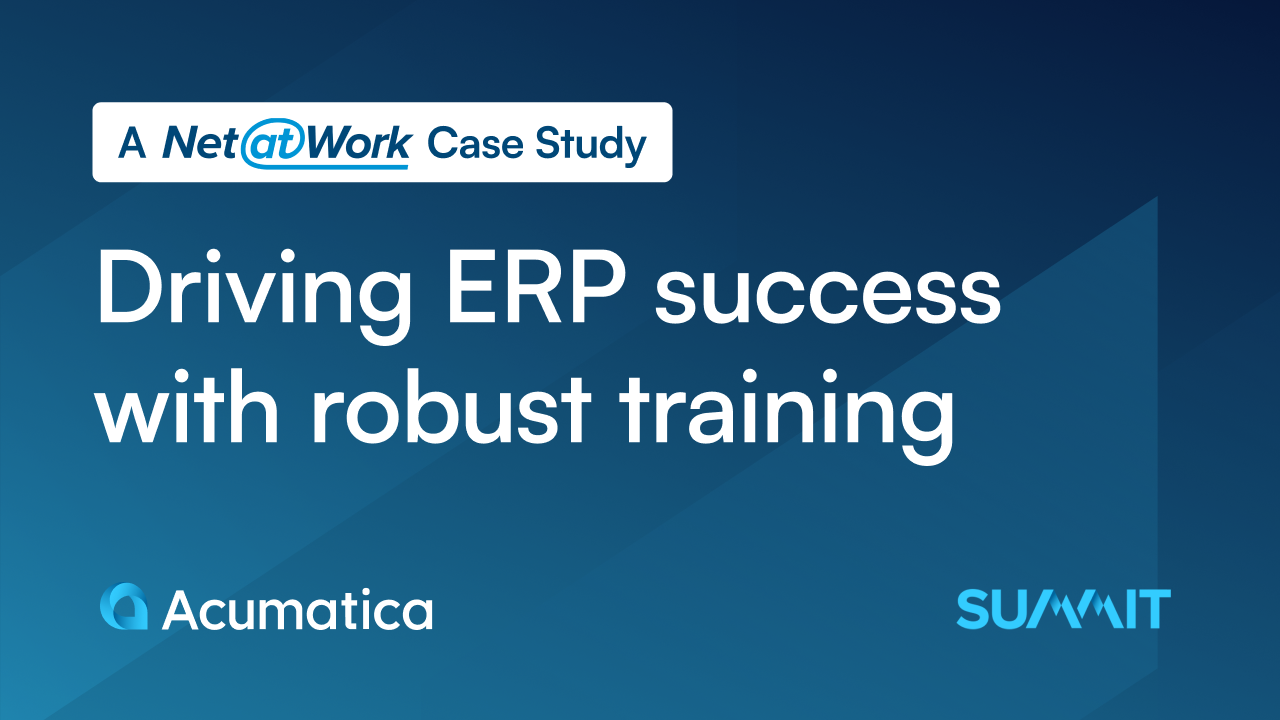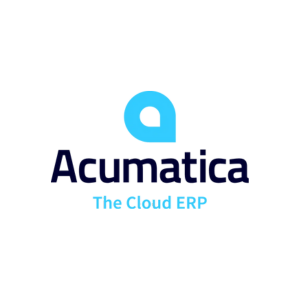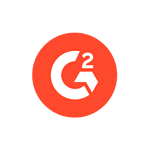Webinar
Driving ERP Success with Robust Training: A Net@Work Case Study
Wondering how to achieve seamless Acumatica implementation and user adoption?
Join us for an exclusive webinar where Net@Work’s Rob Brown will share valuable insights on how to enhance your training methodologies when implementing Acumatica and leveraging technology to scale your training processes. Discover how Net@Work is reducing implementation timelines drastically by leveraging ClickLearn’s User Experience Panel, so that their clients gain access to training and support within Acumatica, boosting self-reliance and overall productivity.
Here is what you’ll Learn:
- The Net@Work journey: How Net@Work has successfully grown its Acumatica practice by building a comprehensive, user-friendly training ecosystem.
- Digital adoption and training: The innovative approaches to digital adoption and training that have helped Net@Work’s clients achieve seamless transitions and successful go-lives.
- ClickLearn’s impact: How ClickLearn’s user adoption tools have revolutionized training and support, making it easier to manage and update training content with Acumatica’s upgrades and features.
Don’t miss out on this opportunity to hear firsthand how to drive effective training and change management that improves user adoption and business outcomes.





The importance of scalable ERP training for project success
Implementing a new ERP system is a massive change that affects users across an organization. A scalable ERP training program is essential to ensure every end-user is equipped to use the system correctly from day one. Net@Work discovered that training isn’t a one-time event delivered only to a handful of key users – it needs to be continuous and far-reaching:
-
Train every user: Rather than only training core team members and hoping knowledge trickles down, make training content accessible to all users. This approach was crucial for Net@Work’s clients, especially those with seasonal staff increases or new hires coming in post-implementation. Everyone from long-tenured employees to incoming staff must be included in the training plan.
-
Consistency at scale: Scalable training means providing consistent, standardized learning materials to hundreds or even thousands of users. With a robust training platform, Net@Work ensured that each user received the same high-quality instruction on ERP processes, regardless of when or where they onboarded.
-
Adaptability: As the business or software evolves, training content should be easy to update and redistribute. (Net@Work noted that with cloud ERP like Acumatica releasing updates twice a year, training documentation must keep up.) A scalable solution allows quick updates so the training stays relevant with each new ERP release or process change.
Investing in scalable training pays off in the long run. When users are well-prepared and confident, ERP projects avoid the common pitfalls of low adoption: resistance to change, workarounds that break processes, and excessive support needs. Instead, organizations see faster ROI from their ERP and smoother daily operations because every user is on the same page.
Why switch from static videos to a dynamic learning platform for ERP training
One major change Net@Work implemented was moving away from traditional video-based training to a more dynamic, interactive training platform. Initially, their training relied on recorded webinar sessions and how-to videos. While videos can be helpful, they discovered several limitations of video-based ERP training:
Limitations of video-based ERP training
Difficult to update: Pre-recorded videos quickly become outdated whenever business processes or ERP interfaces change. Updating a video often means re-recording it from scratch, requiring significant time and technical skill. Net@Work found that relying on video content was unsustainable in a fast-evolving ERP environment.
Time-consuming and linear: Videos are a passive, linear medium. Users have to watch lengthy recordings (often with off-topic tangents or Q&A) to find the information they need. If someone wasn’t part of the original session, it’s hard for them to sift through recordings and absorb the process clearly.
Lack of interactivity: Traditional videos don’t let users practice tasks. Without hands-on interaction, users might not retain what they watched, leading to confusion when they try the real system later.
Maintenance challenges: Every new hire or late adopter would need to watch the same long videos, or someone would have to host repeat training sessions. This approach doesn’t scale well for large or growing teams.
Net@Work recognized these pain points and decided to adopt ClickLearn’s dynamic training platform as a solution. This shift dramatically improved the efficiency and effectiveness of their ERP training content.
Benefits of a dynamic training platform (like ClickLearn)
By using ClickLearn, Net@Work transformed their training materials into a dynamic, easily maintainable library of content. Key advantages of this approach include:
Easy updates & editing: ClickLearn allows training creators to record a process once and then update individual steps or add new steps as needed. There’s no need to re-record entire videos for minor changes. When Acumatica rolled out new features, Net@Work could quickly adjust the relevant training steps, keeping content current.
Multi-format outputs: From a single recording, ClickLearn automatically produces multiple formats – written step-by-step guides (HTML, PDF, Word), PowerPoint decks, and interactive simulations (the “Show Me, Try Me, Test Me” experiences). This means users can learn in the format that suits them best, whether it’s watching a guided demo, trying a hands-on simulation, or reading a quick reference.
Interactive learning & assessment: Unlike a passive video, the platform’s interactive simulations engage users. In “Try Me” and “Test Me” modes, users practice procedures in a safe environment and even get tested on their knowledge. Training managers can track completion and scores through built-in analytics, ensuring users truly learn the material.
In-application guidance: ClickLearn content can be embedded directly into the ERP’s interface or provided via a portal, so users have on-demand help at their fingertips. This in-app guidance means that when someone is unsure how to complete a task in Acumatica, they can trigger a “Show Me” walkthrough or consult the guide right within the system.
Consistency and branding: The platform enabled Net@Work to enforce standards in how processes are documented and explained. They built a templatized approach for content, ensuring every guide or simulation followed best practices in wording and format. This consistency not only looks professional but also reinforces learning by using the same terminology and style across all materials.
By shifting to a dynamic learning platform, Net@Work significantly streamlined their training creation and maintenance process. Even junior team members (such as first-year associates) were able to record and produce quality training content within a week of learning ClickLearn. This meant the firm could scale up content development without pulling senior consultants away from their core work. The result: an up-to-date, interactive training library that serves both their team and their clients effectively.
ERP training as a catalyst for change management and user adoption
A new ERP rollout isn’t just a technology project – it’s a people project. Effective training is a cornerstone of change management, driving the user adoption needed for ERP success. Net@Work’s experience underscores how robust training fuels change management efforts during an ERP implementation:
Winning user buy-in: Many employees are wary of a new ERP, especially if they’ve used an older system for years or decades. Training is an opportunity to “sell” the new system to these users by showing them how it will improve their daily work. As Net@Work points out, users need to believe the new ERP will make their jobs easier or better. Well-designed training sessions – that highlight useful features and efficiencies – help convince users of the benefits, reducing resistance.
Building confidence and competence: Hands-on practice and clear instructional content make users feel more confident in using the ERP. When people feel competent, they are far more likely to embrace the new system. In the case study, ensuring that users were ready by go-live prevented the scenario of frustrated employees “bucking against the system” or creating workarounds. Instead, trained users were able to follow the designed processes, which keeps the ERP functioning as intended.
Inclusive change process: Training also serves as a structured way to involve all departments and stakeholders in the change. Net@Work found that when every department took part in thorough training, those organizations enjoyed smoother go-lives. By engaging users from various teams, training becomes a two-way street: users learn the new system, and the project team gains feedback on real-world use cases and concerns, which can be addressed before go-live.
Reduced change fatigue: Change management is about easing the organization through a transition. If users are left in the dark and only confronted with the new ERP at go-live, stress and confusion skyrocket. By rolling out training gradually before go-live (for example, letting users explore the system via ClickLearn’s simulations weeks in advance), Net@Work ensured that go-live day was a culmination of learning rather than a shocking big bang. Users had already spent time adapting to the change, making the final switch much less intimidating.
In essence, training is the vehicle that drives user adoption. It turns hesitant employees into knowledgeable power-users. Net@Work’s case demonstrates that when training is treated as a strategic part of change management, organizations see higher adoption rates, less pushback, and faster realization of the ERP’s benefits. Users who fully adopt the system can then unlock advanced features and optimizations, further increasing the value of the ERP investment.
How to lower ERP implementation costs and ensure go-live readiness
ERP implementations are notorious for their cost and complexity. An often-overlooked way to control costs and timeline is by improving the efficiency of user training. Net@Work leveraged robust training content to reduce implementation expenses and boost user readiness:
More self-service learning, fewer training hours: Traditionally, consultants spend many hours conducting live training sessions for client teams. By providing ClickLearn training materials early in the project, Net@Work enabled customers to learn basic ERP processes on their own. Users arrived at live training workshops with a baseline understanding and more advanced questions. This significantly reduced the total number of instructor-led hours needed, cutting down billable training costs for the client (and freeing consultant time for other tasks).
Repeatable training content: The firm invested in creating a comprehensive library of ERP process recordings (in one case, over 130 step-by-step recordings covering finance, inventory, project management, etc.). This library became a reusable asset – they can deploy it for multiple clients with minimal tweaks. Instead of reinventing training for each project, much of the work is already done, which lowers delivery costs over time.
Shorter learning curve: Because end-users had access to quality training and practice tools, they climbed the learning curve faster. By the time of go-live, users were not seeing the system for the first time – they had already performed transactions in simulations and reviewed procedure guides. This preparation leads to smoother go-live events with fewer errors and less performance dip. In turn, the project requires less hyper-care support (reducing post-go-live consulting costs).
Improved project timeline: When users learn faster and common mistakes are eliminated through training, the overall project can stay on schedule or even accelerate. For example, if testing cycles (UAT) go quicker because users already know how to execute test scripts (thanks to “Test Me” training exercises), the implementation timeline can be tightened, indirectly saving cost.
Accountability and readiness tracking: Using the analytics from the training platform, Net@Work could verify whether users completed their self-paced training modules. If some users hadn’t engaged with the content, the project team could proactively follow up, preventing unpleasant surprises at go-live. This ensured that go-live readiness wasn’t just assumed – it was measured. Knowing that all users had passed the “Test Me” scenarios gave both the implementer and the client confidence to proceed on schedule.
In summary, a robust training strategy doesn’t just help the users – it improves the project’s bottom line. By reducing the need for repetitive training sessions and avoiding costly go-live issues, effective training contributes to a more efficient, cost-effective ERP rollout. For training managers, this highlights a clear ROI: the better your enablement program, the fewer resources you’ll spend on firefighting and retraining down the line.
How to foster continuous ERP training
Another key insight from the Net@Work case study is that ERP training should be viewed as an ongoing process, not something that ends at go-live. A continuous training model supports both new user onboarding and long-term adoption after the initial implementation:
Onboarding new employees with consistent training
Employee turnover and growth are inevitable. Six months after your ERP is live, you might have new hires or transfers who need to learn the system. Net@Work addressed this by using ClickLearn to create a training repository that new team members could tap into anytime. Instead of scheduling ad-hoc training sessions whenever a new person joins, the training manager can simply assign the relevant ClickLearn learning materials to them.
New employees get the same quality of training as those who went through the initial go-live, ensuring consistency. They can work through interactive tutorials at their own pace and come up to speed quickly.
Because the content is easy to maintain, it stays up-to-date with the latest system processes. Even if onboarding occurs a year post-implementation, the materials reflect the current state of the ERP.
For the organization, this means faster ramp-up for new staff and less disruption. A new finance clerk, for example, can learn how to use the ERP’s Accounts Payable module through the recorded simulations and be productive in days, not weeks.
Net@Work also applied this principle internally: they put junior consultants and new hires through ClickLearn training creation as a form of onboarding. By having new team members produce training content (using pre-defined process scripts), those juniors learned the ERP thoroughly while building useful output. This creative approach enabled the company’s internal knowledge to grow and be documented as a byproduct of onboarding.
Empowering post-go-live support and ongoing adoption
After go-live, users will inevitably have questions or forget how to perform infrequent tasks. Robust training content doubles as a self-service support system in these situations:
Users can refer back to the ClickLearn content (guides or “Show Me” walk-throughs) whenever they need a refresher. This reduces dependency on calling the help desk or super-users for routine queries. Over time, it lightens the support load on IT or the ERP center of excellence.
As the ERP system expands with new features or modules, the training team can create update-specific content and push it out to users. For instance, Net@Work records major new features from Acumatica’s updates in ClickLearn and shares those with clients. This proactive training on new capabilities ensures that user adoption keeps pace with system evolution. Users continue to grow in their knowledge and make the most of the ERP’s expanding functionality.
If your company undergoes changes like acquisitions or department expansions, a scalable training platform ensures you can quickly bring the new groups up to speed. In the webinar, ClickLearn’s team noted that for a rapidly growing organization (Net@Work itself is growing through acquisitions), having scalable training models is critical. It provides a repeatable way to integrate new users into the ERP environment with minimal friction.
Continuous training and easily accessible content foster a culture of self-improvement and autonomy among users. Rather than forgetting what was taught in a one-off class, employees have a go-to knowledge base for ongoing learning. For training managers, this means your efforts continue to deliver value long after the initial project – driving sustained user adoption and proficiency.